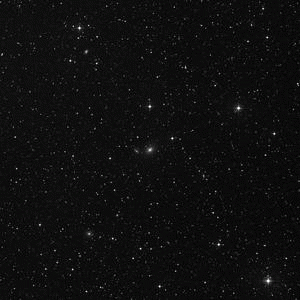IC 4991

Overlaid DSS image of IC 4991, 60' x 60' with north at top and west to the right
Aladin viewer for the region around IC 4991
| Type | Unknown |
|---|---|
| Magnitude | Right Ascension | 20h 18' 23.3" (2000) |
| Declination | 41° 3' 1" S |
| Constellation | Sagittarius |
| Description | vF, cS, R |
Observing Notes
Harold Corwin
IC 4991 comes from Lewis Swift's last year of observing; he found it on 23 September 1897. There is nothing at his position. The nearest galaxy that he might have seen and described as he did ("vF, cS, R, no bright * nr") is ESO 340-G011, a 12th magnitude galaxy, the brightest member of a small group. It is identified as IC 4991 with no qualifications (aside from a note "IC position off 0.6 min, 33'") in the ESO-B Atlas.
However, HD 192815 (V = 8.3) is less than 10 arcminutes north, well within Swift's large 33-arcminute field. Even closer to the west-northwest is CD -41 13952 with V = 9.5. I suspect that if the galaxy were Swift's, he would have mentioned both stars; they would certainly qualify as "bright" as seen through a 16-inch refractor.
As ESO notes, Swift's position is also well off the ESO galaxy. If it were not for the stars near the galaxy, I would have pointed out that Swift's positions from his final observing season are almost invariably bad, and that this one is no different: 37 seconds in RA and 31.9 arcmin in Dec. The Dec in particular is near enough to a digit error of half a degree that I'd be willing to forgive it if that were the only problem. The RA is similarly not much of a problem on its own. Combined with the Dec, however, and the nearby bright stars, I am now very skeptical of the identification.
Swift's published data for the object, by the way, are consistent from list to list among his four papers including this object. So, we can't easily invoke a typo. Still to be checked, of course, are the coarser digit errors (1 hour in RA, 10 degrees in Dec, and so on).
Finally, Malcolm Thomson and Courtney Seligman point out that the galaxy is a pretty bright one. (Indeed, we might ask why didn't John Herschel pick it up from CGH?) This being the case, why did Swift describe it as "vF"? The answer is in the declination, I think. At -41 degrees, the galaxy would be only 15 degrees above Swift's southern horizon. Even in 1897, the air over Los Angeles would not be pristine, so the galaxy would suffer a bit (perhaps considerably more than that!) of extinction.
All in all, then, the identification of Swift's object with ESO 340-G011 is fraught with difficulty. Malcolm noted the problems and concluded "Not found." I'm very tempted to agree with him, but list the ESO galaxy -- with a question mark -- as a possible candidate.
Other Data Sources for IC 4991
Nearby objects for IC 4991
2 objects found within 120'
| Kappa1 Sagittarii | Kappa2 Sagittarii |
Credits...
Drawings, descriptions, and CCD photos are copyright Andrew Cooper unless otherwise noted, no usage without permission.
A complete list of credits and sources can be found on the about page
IC 4991